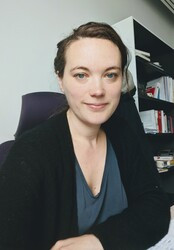Anne Gosselin
INED researcher Anne Gosselin tells us about the research project she’s conducting on workplace health issues with a community association called VoisinMalin [Wise neighbor].
(Interview conducted in March 2024)
Can you tell us about this project with VoisinMalin, which got under way in 2023?
The project is funded by the Agence Nationale de la Recherche (ANR) and co-funded by the Agence Régionale de Santé (ARS) for the association. The aim is to acquire better knowledge and understanding of occupational risks among residents of three working-class neighborhoods in the Ile-de-France region, and of the neighborhoods’ resources and existing services. The VoisinMalin association does door-to-door information diffusion campaigns and outreach in the three neighborhoods; the campaigns are conducted by neighborhood inhabitants employed by the association.
How did this collaboration with INED come about?
VoisinMalin has been working for several years on health-related subjects. The association applied for ARS project grants in support of projects that work to impact health determinants, with a special focus on ties between health and work. They contacted Annabel Desgrées du Loû, a senior researcher at the CEPED laboratory (Centre Population et Développement) of the Research Institute for Development (IRD), and me to collaborate on this action research project.
Other researchers are also participating: INED researcher Emilie Counil, and post-doc sociologist Sarah Demichel-Basnier, who came to INED in September 2023 to work on the project for a period of two years.
The specificity of the project is that it came into being and is being conducted as a participative action with association employees. They go door-to-door speaking with people experiencing health problems that might be related to their work, and in some cases they don’t have the information necessary to orient residents in the neighborhoods they work in.
Regular meetings are held between INED researchers and residents of the three priority neighborhoods in the projects to discuss what directions to take, what issues to cover, and how to implement our choices.
How is the project going to unfold?
The project got underway in September 2023 and will continue through the first half of 2025.
In the first phase, working with the VoisinMalin teams, we developed a questionnaire for residents on their occupational situation, state of health, links between the two, and what they know about their rights and the various existing resources related to workplace health. To date, we have identified the following priority concerns: access to rights; work-related mental health, particularly for people with low-paying, unstable jobs; and inhabitants’ existing strategies for taking care of their health in the workplace. We’re also asking about atypical working hours.
The questionnaire survey is scheduled for distribution to 1,200 respondents in a wide range of work situations in Spring 2024, which means we should have our first findings by Fall 2024. Then, on the basis of the questionnaire results and together with the association, we’ll construct a plan for promoting workplace health in the three neighborhoods involved in the project.
Also in Fall 2024, there will be a second door-to-door campaign to meet with 1,200 people living in the same neighborhoods where the first campaign took place, this time to enact the workplace-health promotion plan. The aim at this point will be to diffuse information on health and work and on what procedures and solutions may be possible at the neighborhood level (we will not be questioning the same inhabitants again or doing follow-up on those respondents). Then Sarah Demichel-Basnier will do a qualitative segment, drawing on observation of this group and interviews with its members to understand whether our intervention has had an impact on what people know and what they may have tried to do about their health in the workplace.
The VoisinMalin association is used to working with local actors. We plan to share the questionnaire results with those actors and to use the results to determine what other actions could be proposed to or undertaken for the residents of the three neighborhoods.
Are there any particular difficulties involved in conducting this type of project?
One difficulty is that the residents who work for VoisinMalin are the ones who question neighborhood inhabitants. That can be a delicate situation if they already know each other. So we will take care not to have neighbors survey inhabitants in their own apartment buildings. On the other hand, the fact that the residents know the VoisinMalin teams who intervene regularly in their buildings can be an asset because a relationship of trust may already exist.
Another difficulty is that the participative method requires us to find ways of working that suit both INED researchers and VoisinMalin association workers, and that implies learning about each other and spending a considerable amount of time getting our schedules to fit together. These efforts have already had a beneficial effect on questionnaire construction and will surely be very fruitful when the time comes to analyze the study findings.

